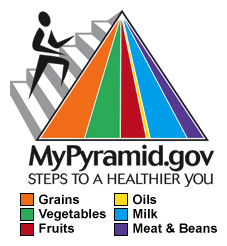
MyPyramid
MyPyramid is a healthy eating plan that helps you:
- Make smart choices from different food groups
- Balance the number of calories you "burn" through physical activity with the number of calories you eat so that you maintain a healthy weight
- Get plenty of healthy nutrients from the food you eat
The Pyramid has six color-coded stripes, each standing for a different food group. The food groups are:
- Grains
- Vegetables
- Fruits
- Milk and milk products (such as cheese, yogurt, and milk-based desserts)
- Meat and beans (including red meat, poultry, fish, dry beans, eggs, and nuts)
- Oils
Want to know the amount of each food group you need daily? Go to MyPyramid Plan and enter your age, sex, weight, height, and the amount of physical activity you get on most days. After entering this information, you'll get a customized food guide that will tell you how many calories a day you can eat to maintain a healthy weight. It will also tell you (in cups or ounces) how much of each type of food you should eat each day.
If you don't want to use measuring cups and a food scale to measure out your food, take a look at the How Much Do YOU Eat? poster (PDF, 674 Kb). It uses everyday items to help you judge the amounts of various foods you should eat. For instance, one cup of broccoli is about the size of a baseball, and a half cup of sliced fruit is about the size of a small computer mouse.
Besides the different colored stripes in MyPyramid, do you also see the figure running up the steps of the pyramid? He stands for physical activity, which is discussed in the Staying Active section.
More information on mypyramid
Read more from womenshealth.gov
-
Heart Healthy Eating Fact Sheet — This fact sheet provides information on how healthy eating habits can help to reduce the risk of heart disease. It explains what a healthy portion is and how to make heart-healthy food choices.
http://www.womenshealth.gov/publications/our-publications/fact-sheet/heart-healthy-eating.cfm
Explore other publications and websites
-
Alcohol: Frequently Asked Questions — This website answers questions about alcohol such as the difference between moderate drinking and heavy alcohol use, signs of problem drinking, and how alcohol affects special populations.
http://www.cdc.gov/alcohol/faqs.htm
-
ChooseMyPlate.gov — This interactive site is based on the 2010 Dietary Guidelines for Americans and gives information on how much of each food group you should eat each day. It also includes tips and resources for planning a well-balanced and healthy diet.
http://www.choosemyplate.gov/
-
Pregnancy & Breastfeeding — When you are pregnant or breastfeeding, you have special nutritional needs. This website is designed just for pregnant and breastfeeding women and includes important advice to help keep mothers and babies healthy.
http://www.mypyramid.gov/mypyramidmoms/index.html
-
What Is the DASH Eating Plan? — This website talks about the Dietary Approaches to Stop Hypertension eating plan and how it can help lower blood pressure. It also has links to more information on the benefits of DASH, how to follow the diet, and living a healthy lifestyle.
http://www.nhlbi.nih.gov/health/dci/Diseases/dash/dash_what.html
-
When Delicious Meets Nutritious: Recipes for Heart Health — Here's some terrific news: What's good for your heart is great for your taste buds. The recipes in this pamphlet show you don't have to lose flavor to gain health. Heart-healthy cooking simply means making dishes that are low in saturated fat, total fat, cholesterol, and sodium. As an added bonus, these dishes have fewer calories than those higher in fat. Recipes include "Classic Macaroni and Cheese" and "1-2-3 Peach Cobbler."
http://www.nhlbi.nih.gov/health/hearttruth/material/factsheet_recipes.pdf
-
Your Guide to Lowering Your Blood Pressure With DASH — Get with the plan that is clinically proven to significantly reduce blood pressure! This booklet offers a week's worth of sample menus and recipes created to follow the most recent nutritional guidelines. The Dietary Approaches to Stop Hypertension (DASH) eating plan features plenty of fruits, vegetables, whole grains, and other foods that are heart healthy and lower in salt and sodium. It also provides additional information on weight loss and physical activity.
http://www.nhlbi.nih.gov/health/public/heart/hbp/dash/new_dash.pdf
Connect with other organizations
-
American Dietetic Association
http://www.eatright.org/default.aspx
-
American Heart Association
http://www.heart.org/HEARTORG/
-
National Heart, Lung, and Blood Institute
http://www.nhlbi.nih.gov/index.htm
-
Nutrition.gov
http://www.nutrition.gov/
-
Weight-Control Information Network
http://win.niddk.nih.gov/index.htm
Content last updated June 17, 2008.
Resources last updated June 17, 2008.
womenshealth.gov
A federal government website managed by the Office on Women's Health in the Office of the Assistant Secretary for Health at the U.S. Department of Health and Human Services.
200 Independence Avenue, S.W. • Washington, DC 20201


 Text size
Text size Email
Email
